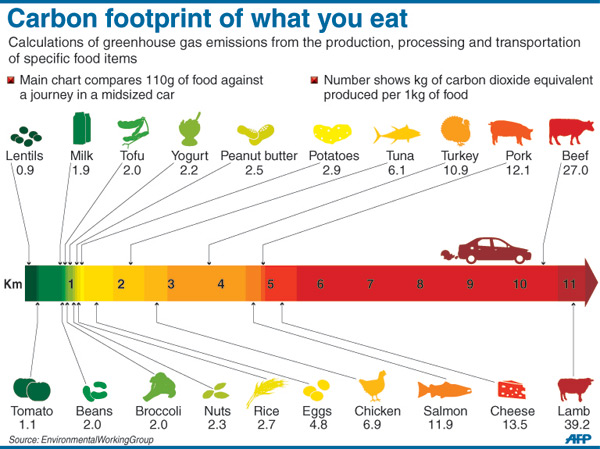70 BILLION ANIMALS A YEAR! We collectively raise, feed, water, kill for food and eat over 70 billion animals each year (1), ten times as many people as we have on the entire earth.
In doing so, these animals use and deplete our renewable and nonrenewable resources – they use food, water, land, air and fossil fuels or other energy sources that could or should be used for us. We have developed a complex system of producing more and more animals that use more and more of our resources, while leaving a massive amount of waste, pollution and adverse climate change in their way.
55% of our fresh water is given to livestock (2). Over 30% of all usable total landmass on earth is used by livestock. Over 80% of all arable agricultural land in the US is used for or by livestock (3). Over 70% of the grain in the US is fed to livestock (4). Transporting food from the producer to the retailer is responsible for only 4% of all the fossil fuels used and all greenhouse gases emitted in the entire food production process (5). Whereas eating animals equates to 18-51% (U.N – World Bank Group) of all greenhouse emissions. So, although eating local is important for many different reasons, eating plant based is crucial to slow down global warming progression.
It takes 10 to 20 gallons of water to produce one pound of vegetables, fruit, soybeans or grains. It takes 5,000 gallons of water to produce one pound of meat (6). A cow needs 30 gallons of water each day just to stay alive, and a pig needs up to 21 gallons (7). Producing one calorie of animal protein requires more than 10 times as much fossil fuel input and produces more than 10 times as much CO2 as does one calorie of plant protein (8).
One acre of land, if used for vegetables, grain, and/or legumes, produces ten to fifteen times more protein than if devoted to meat production (9). On any given acre of land we can grow 12 to 20 times the amount of edible vegetables, fruits and grain as in pounds of edible animal products (10). We are essentially using 20 times the amount of land and crops, and hundreds of times the water, as well as polluting our waterways and air, and destroying rainforest, to produce animals to kill and eat… which is unhealthier than eating the plant foods we could have produced (11).
According to the Global Footprint Network (GFN), the global demand for land overtook global supply by the end of the 1980s. GFN was established in 2003 to measure human impact on earth. The organisation comprises scientist, non-governmental organisations (NGOs), academics, and over ninety global partners that are universities and technological institutions, and is supported by twenty-three countries. Their “footprint” is a data driven tool of measurement that tells us if we are living within our ecological budget, or if we are using natural resources faster than the planet can renew them. It’s estimated that the human ecological footprint is currently 30% greater than the entire planet can sustain (12). Moderate projections suggest that if consumption and depletion continue at current levels, we will need the equivalent of two earths to support us by the mid-2030s (13).
If we like to slow down not just global warming but global depletion, and we like to leave a planet where life as we know is possible for future generations to come, the single most important thing we can do that will have the biggest impact in slowing down this catastrophic process, is to adopt a plant based diet.

Agree!
LikeLike